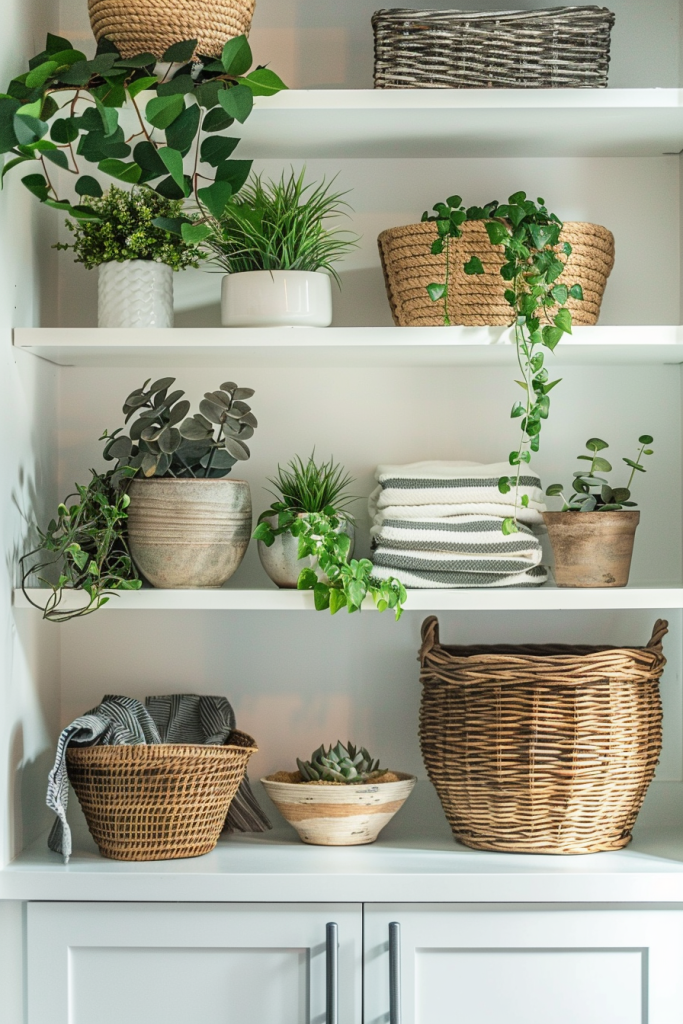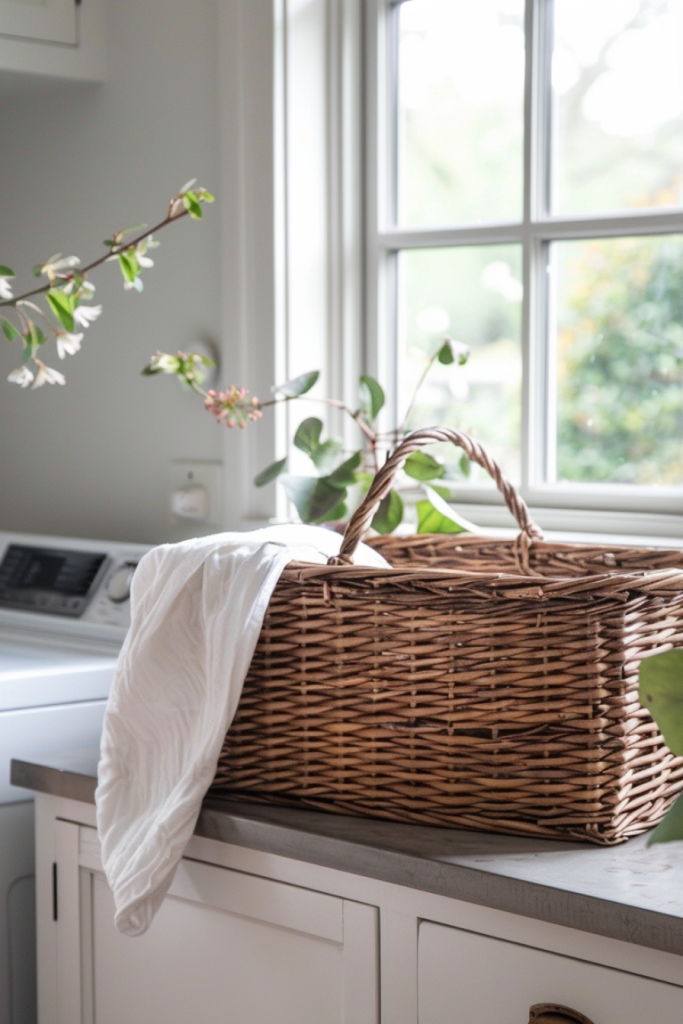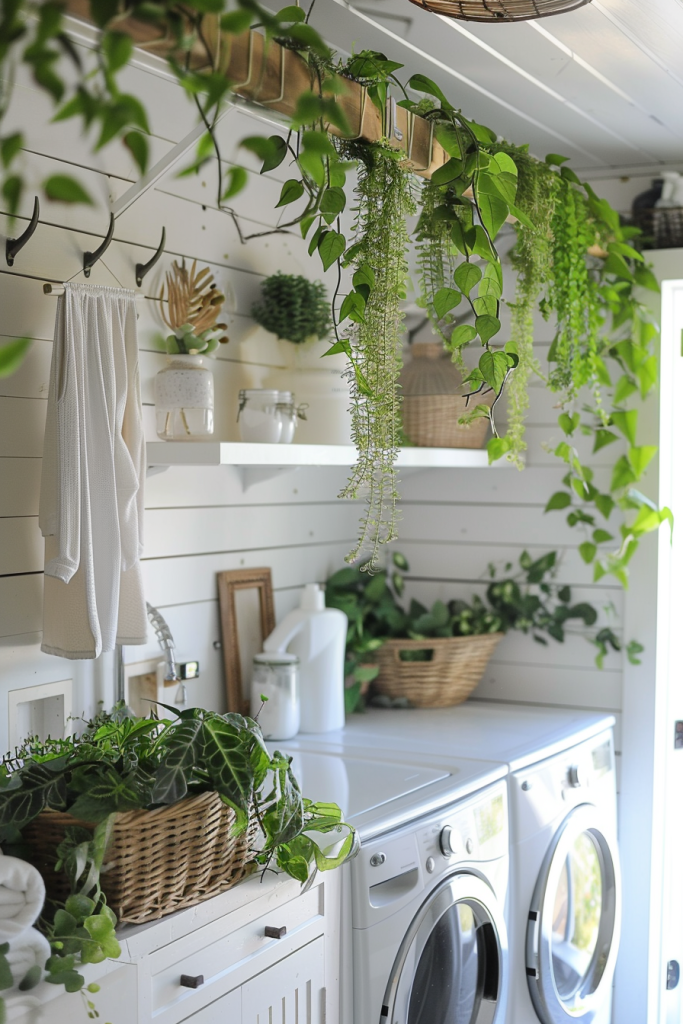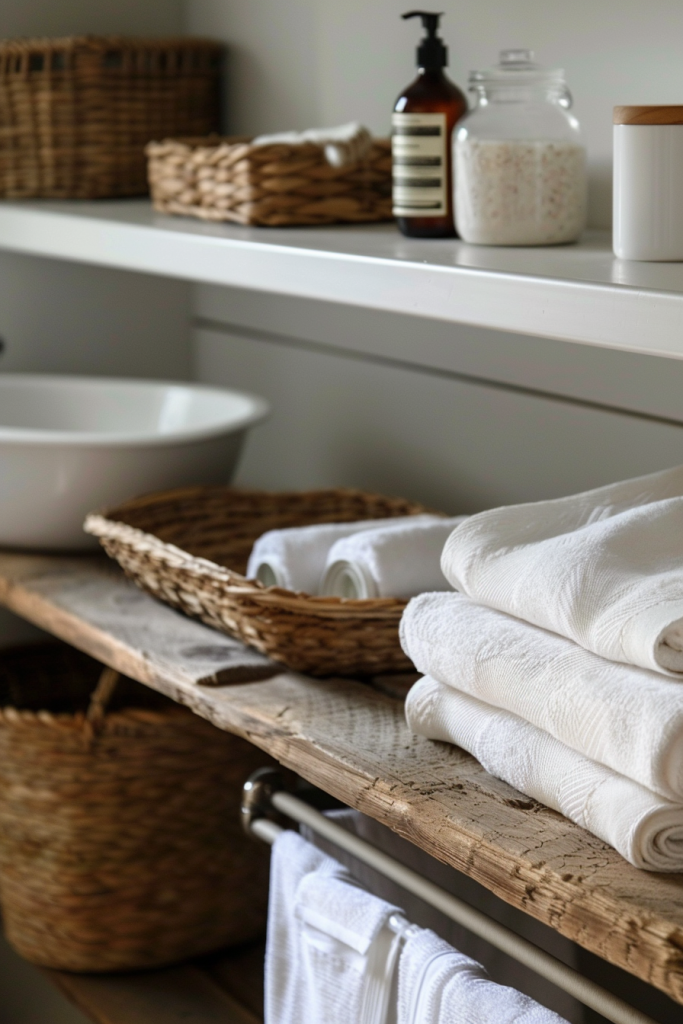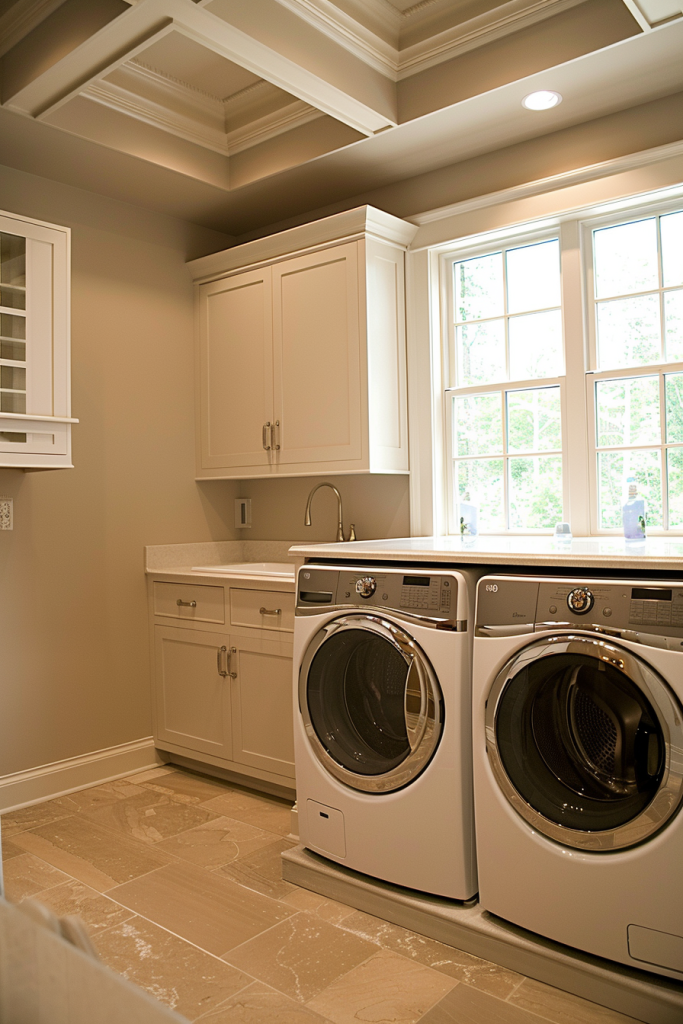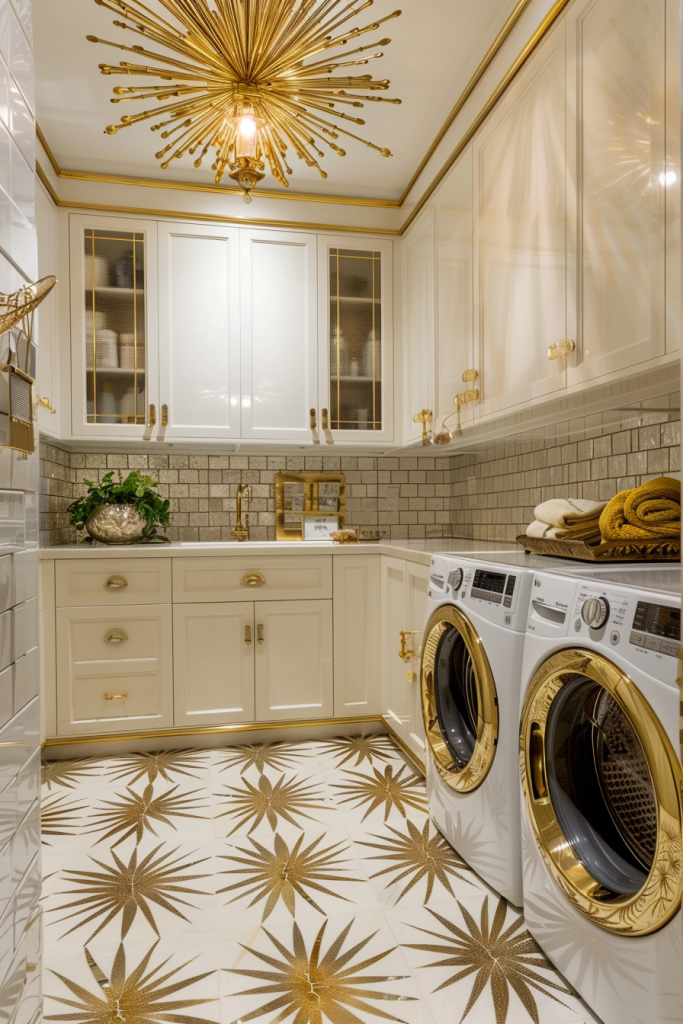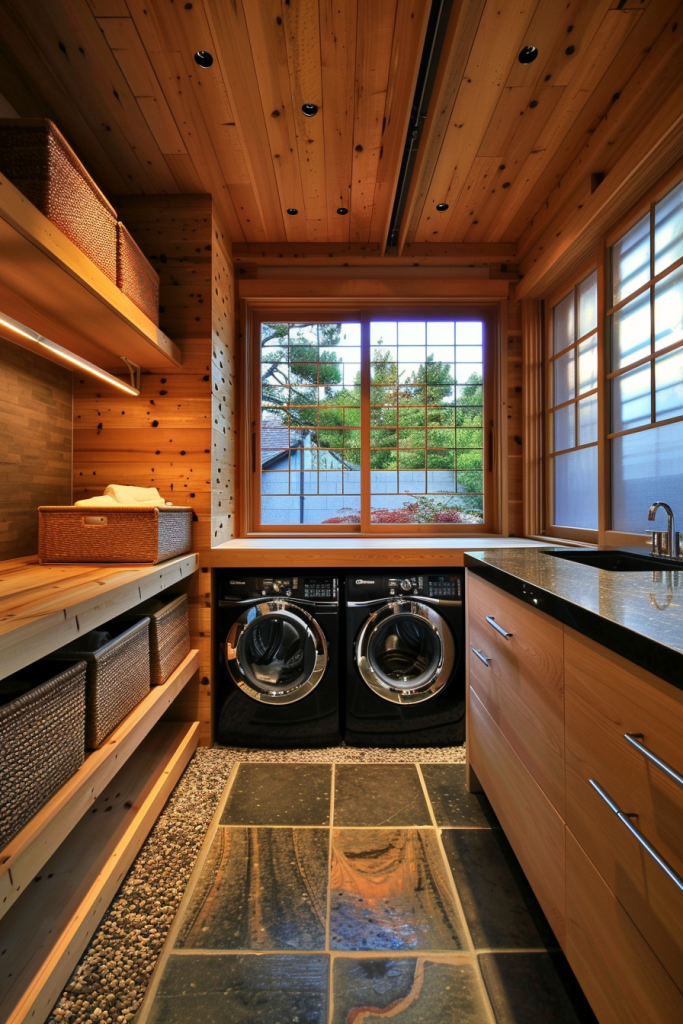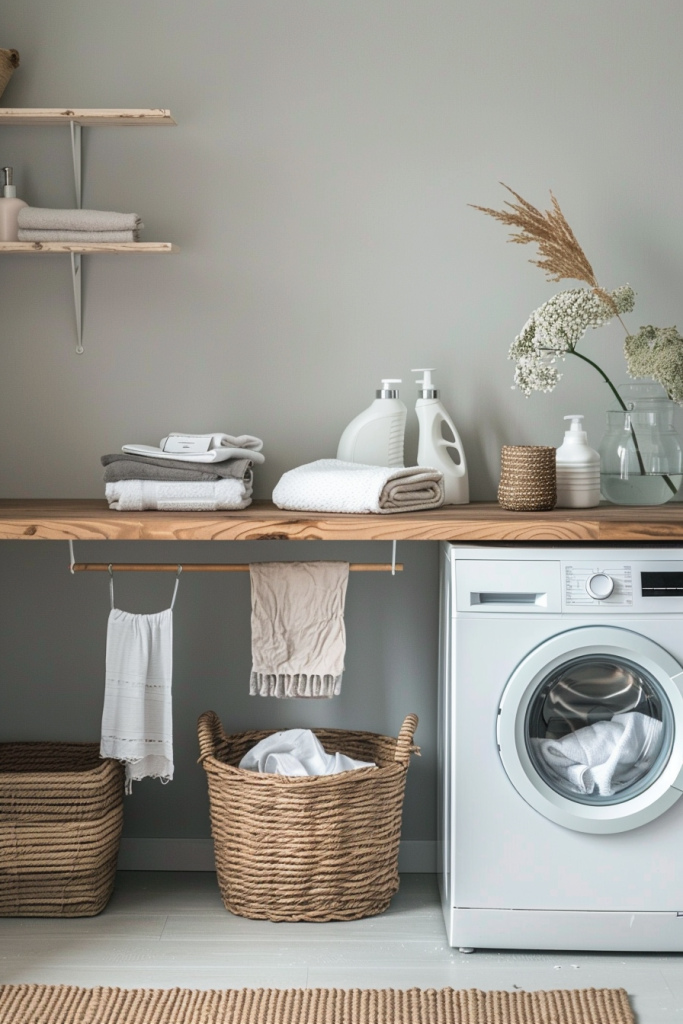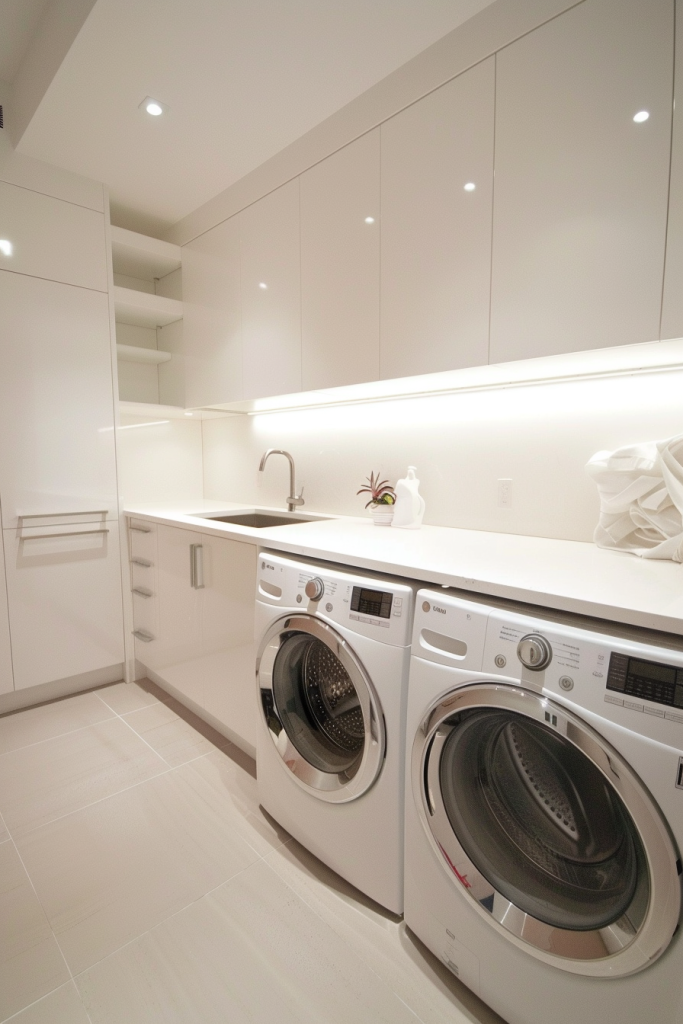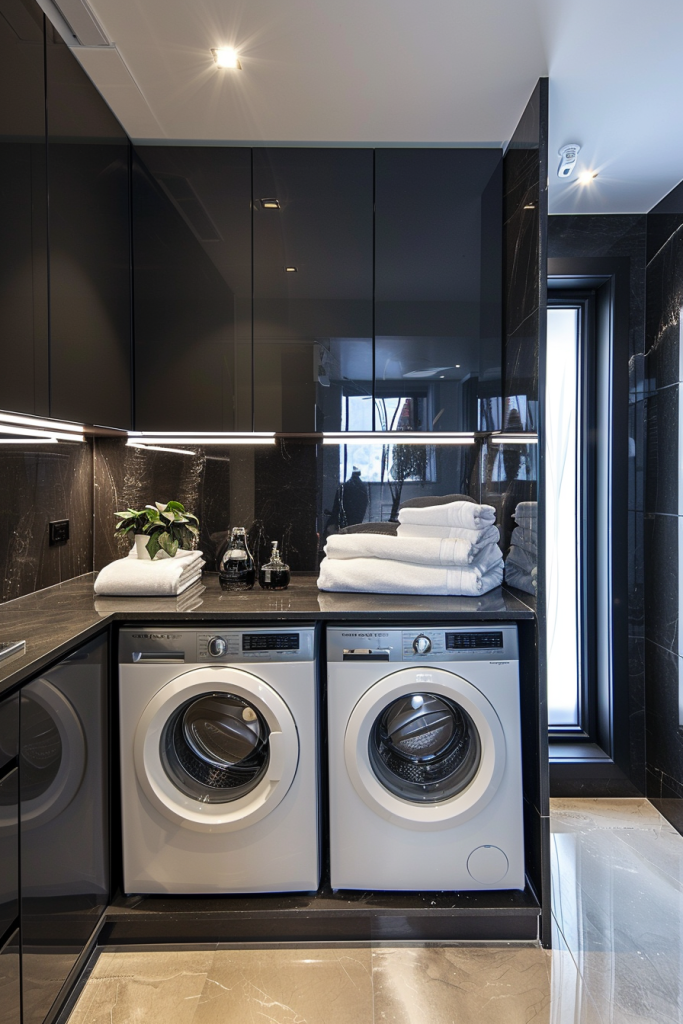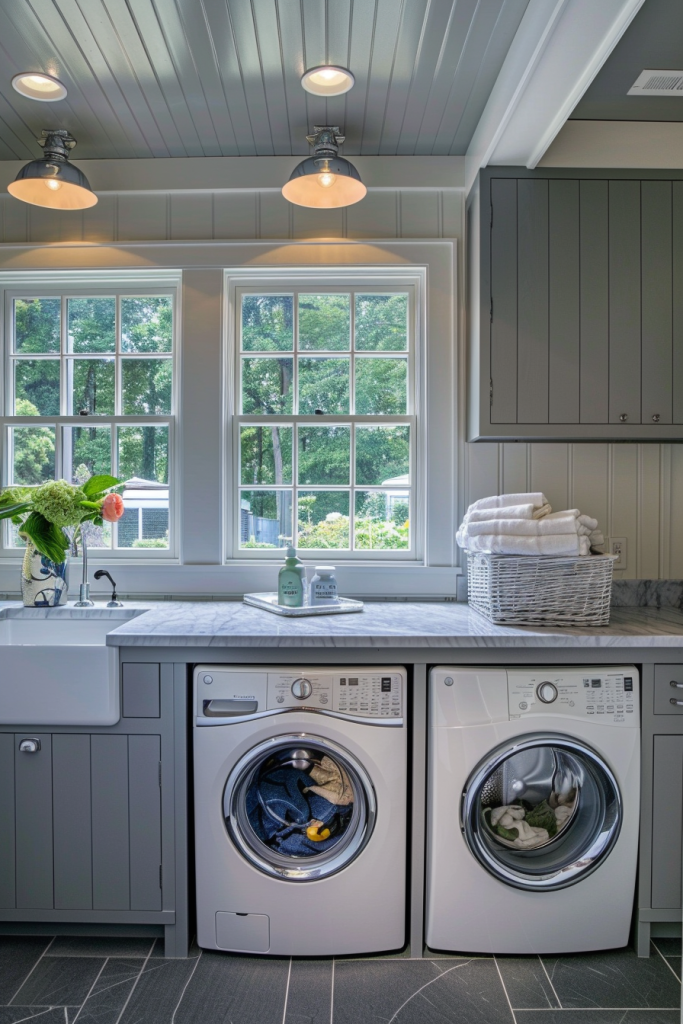- Historical and Cultural Significance
- Impact on Mood and Atmosphere
- Understanding Your Space
- Design Inspirations
- Planning Your Layout
- Choosing Your Color Scheme
- Selecting Materials and Textures
- Lighting the Room
- Tech and Smart Features
- Decor and Finishing Touches
- Budgeting and Planning
Laundry rooms have evolved from purely functional spaces to stylish areas that can enhance the overall aesthetic of a home. Modern laundry room design draws inspiration from various decor themes, blending practicality with visual appeal.
This guide explores how to create a dream laundry room that is both functional and beautiful, ensuring your laundry space is a place of efficiency and style.
Historical and Cultural Significance
The concept of a dedicated laundry room is relatively modern, with historical washing practices being more communal and less specialized. Over time, the laundry space has transitioned from an outdoor or basement chore area to an integral part of the home’s design.
This evolution reflects cultural shifts towards convenience and the desire for aesthetically pleasing living spaces. Modern laundry rooms often incorporate elements from various historical decor styles, blending old-world charm with contemporary convenience.
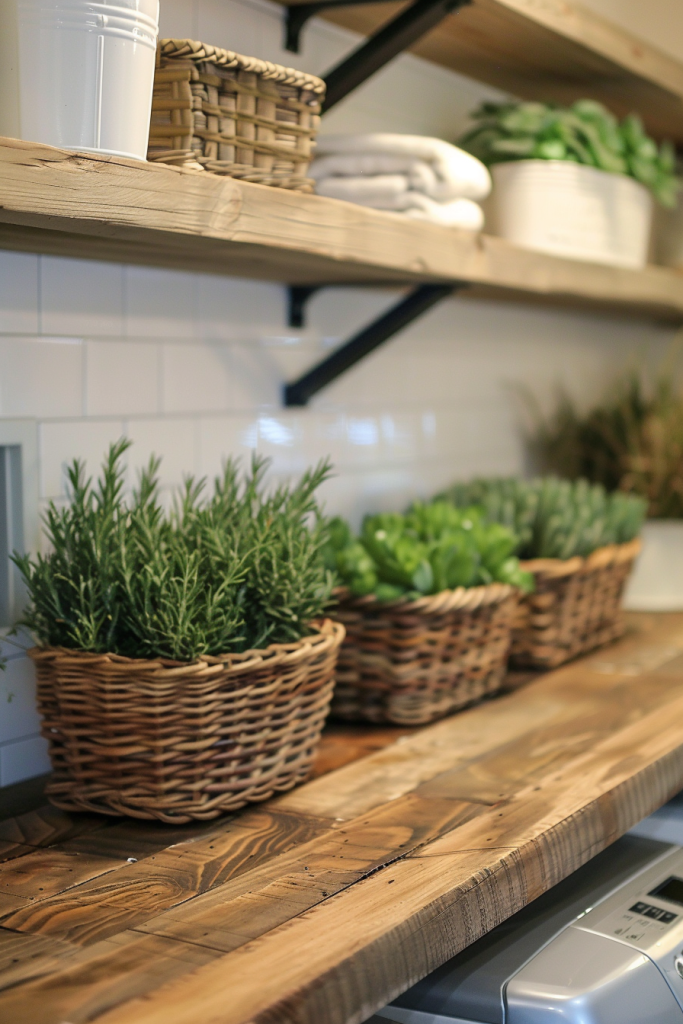
Impact on Mood and Atmosphere
- A well-designed laundry room can streamline tasks, making the process faster and less stressful. This efficiency can lead to a greater sense of accomplishment and satisfaction.
- A stylish laundry room can uplift your mood and make laundry chores more pleasant. Beautiful design elements and a cohesive color scheme can transform the space into a place you enjoy spending time in.
- An organized space can reduce stress and create a sense of calm. Knowing exactly where everything is and having a clean, tidy environment can make laundry tasks feel less overwhelming.
- Personal touches, such as decorative accents and a well-thought-out design, can make the laundry room a more enjoyable space. This can positively influence your overall attitude towards household chores.
Understanding Your Space
Creating your dream laundry room starts with understanding the space you have. This foundational step ensures that your design and planning efforts are tailored to fit the specific characteristics of your room, maximizing both functionality and aesthetics.
Measurements
Begin by taking precise measurements of your laundry room. This includes the length, width, and height of the room, as well as the dimensions of any existing fixtures, doors, and windows. Having accurate measurements helps in:
- Planning the Layout: Ensuring that your chosen furniture and appliances fit comfortably without overcrowding the room.
- Buying Materials: Ordering the correct amount of flooring, paint, or other materials.
- Custom Solutions: Creating built-in storage or custom cabinetry that fits perfectly into your space.
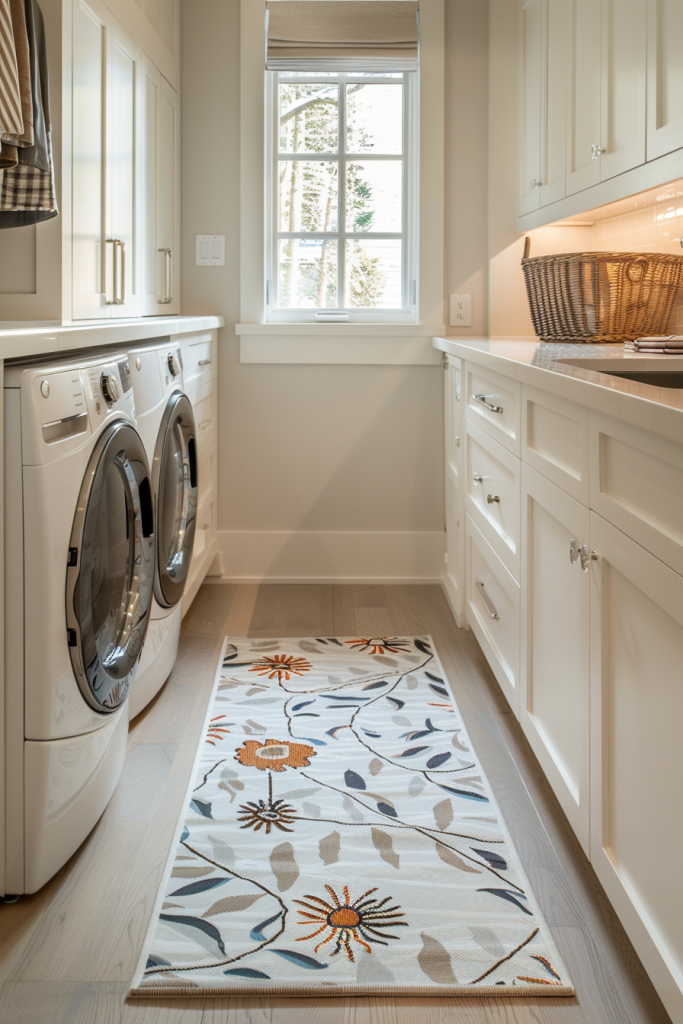
Natural Light
Assess the amount of natural light available in your laundry room. Natural light can significantly impact the room’s ambiance and functionality.
- Light Sources: Identify windows, skylights, or other sources of natural light.
- Lighting Enhancement: Consider how you can enhance or manage natural light with window treatments like blinds, shades, or curtains.
- Color Choices: Lighter colors can reflect natural light and make the room feel more spacious, while darker colors can create a cozy atmosphere if the room is already well-lit.
Current Layout
Evaluate the current layout of your laundry room and identify any areas for improvement. Consider how the existing setup supports or hinders your laundry tasks.
- Workflow Efficiency: Analyze the flow from one task to another, such as sorting, washing, drying, and folding. An efficient layout minimizes unnecessary movement.
- Appliance Placement: Ensure that appliances are placed conveniently. For example, having the washer and dryer side by side or stacked can save space and streamline the process.
- Accessibility: Ensure that all areas of the room are easily accessible, including storage cabinets and countertops.
Existing Fixtures and Features
Take note of existing fixtures and features that you plan to keep, such as plumbing, electrical outlets, and ventilation. These elements will influence your design choices and layout plans.
- Plumbing: The location of water and drain lines will determine where you can place your washer and dryer.
- Electrical Outlets: Ensure there are enough outlets to power all your appliances and any additional lighting or accessories.
- Ventilation: Proper ventilation is crucial to prevent mold and mildew. Assess if the current ventilation system is adequate or if it needs upgrading.
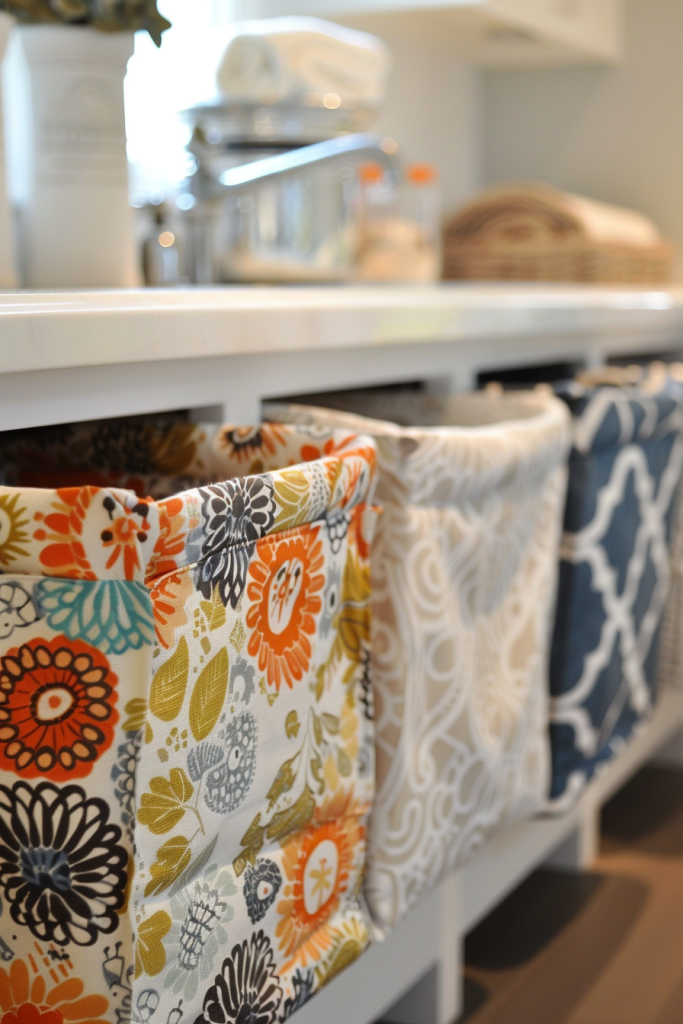
Space Utilization
Think about how you currently use the space and how you can improve its utilization.
- Storage Needs: Identify your storage needs for detergents, cleaning supplies, and laundry baskets. Consider adding shelves, cabinets, or built-in storage solutions.
- Multifunctional Use: If space allows, consider integrating other functions into your laundry room, such as a mudroom, pet cleaning station, or craft area.
Challenges and Opportunities
Every space has its unique challenges and opportunities. Identify any potential obstacles and think creatively about how to overcome them.
Underutilized Areas: Look for underutilized areas such as corners, above appliances, or behind doors that can be optimized for storage or additional functionality.
Small Spaces: In smaller laundry rooms, look for space-saving solutions like stacked appliances, wall-mounted drying racks, and fold-out ironing boards.
Unusual Shapes: Irregularly shaped rooms can be challenging but also offer opportunities for custom solutions that make the most of every inch.
Design Inspirations
Designing your dream laundry room involves exploring various styles to find the one that resonates with your personal taste and the overall aesthetic of your home. Here are some popular design inspirations to help spark your creativity and visualize the potential of your space.
Modern
Modern design is characterized by clean lines, minimalistic elements, and a neutral color palette. This style focuses on simplicity and functionality without sacrificing elegance.
- Key Features: Sleek cabinetry, stainless steel appliances, and simple hardware.
- Color Palette: Predominantly neutral tones such as white, gray, and black, often accented with bold, single-color elements.
- Materials: Glossy finishes, glass, and metals.
- Decor: Minimal decor, with an emphasis on geometric shapes and clean surfaces.
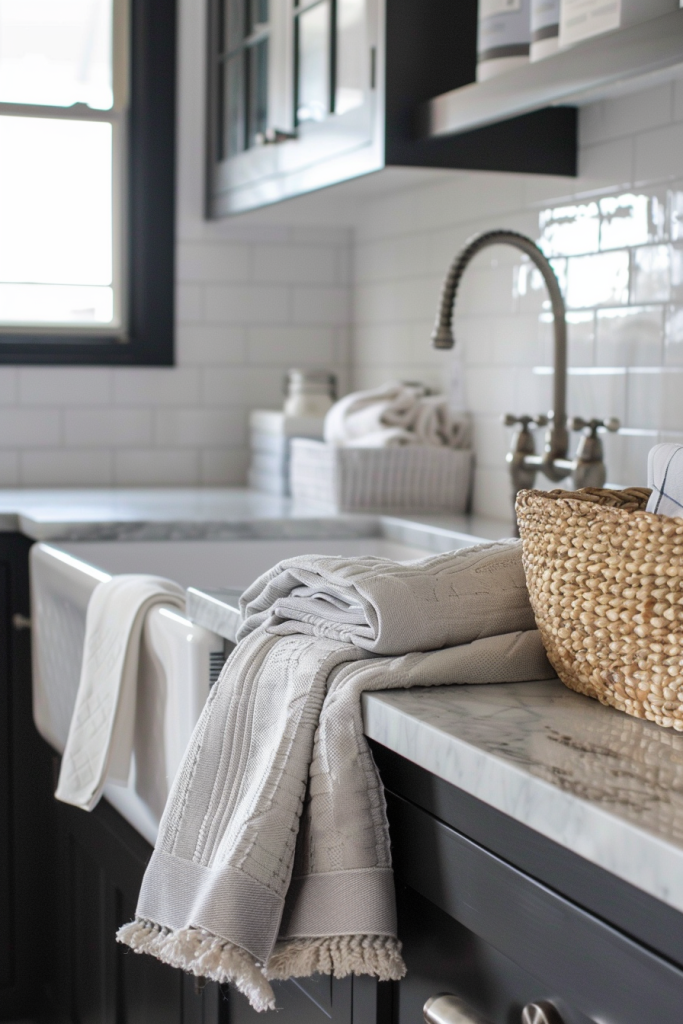
Minimalist
Minimalist design takes the modern style a step further by emphasizing simplicity and decluttering. The focus is on essential elements, creating a serene and unencumbered space.
- Key Features: Open shelving, hidden storage, and unobtrusive appliances.
- Color Palette: White, soft grays, and other light, neutral colors.
- Materials: Natural wood, stone, and simple textiles.
- Decor: Very few decor items, with an emphasis on functionality over form.
Traditional
Traditional design brings a timeless and cozy feel to the laundry room. This style incorporates classic elements and rich details that evoke a sense of warmth and homeliness.
- Key Features: Detailed cabinetry, ornate hardware, and vintage-inspired fixtures.
- Color Palette: Warm tones such as cream, beige, and rich wood finishes.
- Materials: Wood, ceramic tiles, and traditional fabrics.
- Decor: Decorative molding, framed artwork, and antique accessories.
Farmhouse
Farmhouse design combines rustic charm with modern comforts. This style is perfect for creating a welcoming and functional laundry room that feels both nostalgic and fresh.
- Key Features: Shiplap walls, apron-front sinks, and open shelving.
- Color Palette: Soft, muted colors like white, pale blue, and earthy tones.
- Materials: Reclaimed wood, galvanized metal, and cozy textiles.
- Decor: Mason jars, wicker baskets, and vintage signs.
Industrial
Industrial design is inspired by old factories and industrial spaces, emphasizing raw and unfinished elements. This style is both bold and functional, making a strong visual statement.
- Key Features: Exposed pipes, metal fixtures, and concrete surfaces.
- Color Palette: Darker tones such as black, gray, and brown, often contrasted with natural wood.
- Materials: Metal, brick, concrete, and reclaimed wood.
- Decor: Vintage industrial lighting, wire baskets, and utilitarian decor.
Scandinavian
Scandinavian design is known for its simplicity, functionality, and connection to nature. This style creates a bright and airy laundry room with a clean and uncluttered look.
- Key Features: Simple lines, functional furniture, and a focus on light.
- Color Palette: Whites and light neutrals, often accented with soft pastels.
- Materials: Light wood, natural textiles, and minimalistic hardware.
- Decor: Potted plants, woven baskets, and simple, functional decor.
Eclectic
Eclectic design allows for a mix-and-match approach, blending different styles, colors, and textures to create a unique and personalized space.
- Key Features: A combination of various styles and periods, with no strict rules.
- Color Palette: A mix of bold and neutral colors, allowing for creativity and personal expression.
- Materials: A variety of materials, from metals and woods to fabrics and glass.
- Decor: A diverse collection of decor items, from vintage finds to modern art, creating a curated and cohesive look.
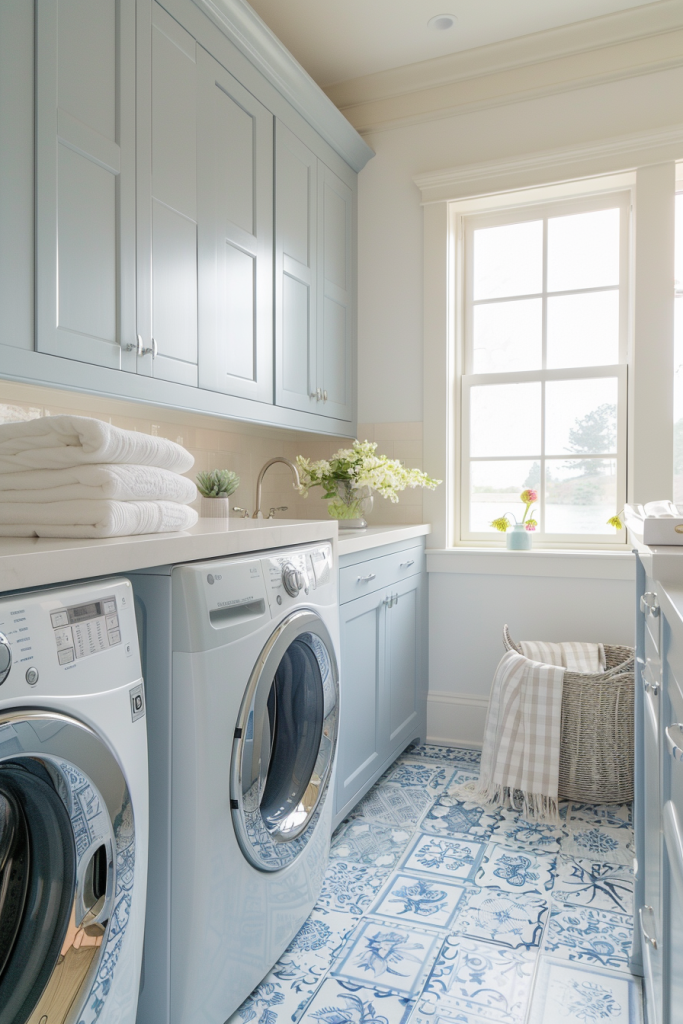
Coastal
Coastal design brings a breezy, beachy feel to your laundry room, making it feel fresh and relaxing. This style is perfect for homes near the water or for those who love a maritime aesthetic.
- Key Features: Light, airy spaces with a focus on natural light and seaside-inspired decor.
- Color Palette: Whites, soft blues, sandy beiges, and ocean-inspired hues.
- Materials: Natural fibers, weathered wood, and light, breezy fabrics.
- Decor: Nautical elements, such as seashells, driftwood, and marine-themed artwork.
Glam
Glam design infuses your laundry room with luxury and sophistication. This style is all about making a bold statement with opulent details and high-end finishes.
- Key Features: High-gloss surfaces, crystal chandeliers, and mirrored accents.
- Color Palette: Rich, deep colors such as jewel tones, gold, silver, and black.
- Materials: Velvet, marble, metallic finishes, and plush textiles.
- Decor: Elegant decor pieces, such as gold-framed mirrors, luxurious rugs, and decorative trays.
Bringing It All Together
Once you’ve explored these design inspirations, consider how they align with your personal style and the overall aesthetic of your home. Create a mood board to visualize your ideas, combining elements from different styles if needed.
This process will help you make informed decisions and create a cohesive and beautiful laundry room that reflects your unique taste and meets your practical needs.
Planning Your Layout
A well-planned layout is essential for creating a functional and aesthetically pleasing laundry room. This involves careful consideration of how the space will be used, the placement of appliances and furniture, and innovative storage solutions. Here’s a detailed guide to help you plan the perfect layout for your laundry room.
Functionality First
When designing your laundry room layout, prioritize functionality. This means ensuring that the space efficiently supports all your laundry tasks, from sorting and washing to drying and folding.
- Workflow: Arrange the room to follow the natural flow of laundry tasks. Ideally, the process should move from dirty laundry to clean and folded clothes with minimal backtracking.
- Zones: Create distinct zones for each task. For example, designate areas for sorting, washing, drying, folding, and ironing.
- Ease of Access: Make sure that all appliances and storage solutions are easily accessible. This reduces the time and effort needed to complete laundry tasks.

Furniture Placement
Selecting and placing furniture strategically can enhance both the functionality and aesthetics of your laundry room.
- Countertops: Install countertops above your washer and dryer if they are front-loading. This provides a convenient surface for folding clothes or treating stains.
- Cabinets and Shelving: Place cabinets and shelves within easy reach of your work areas. Wall-mounted cabinets above appliances can maximize vertical space.
- Utility Sink: If space allows, include a utility sink for hand-washing delicate items or pre-treating stains. Position it near the washer for convenience.
- Ironing Board: Consider a fold-out ironing board that can be stowed away when not in use to save space.
Storage Solutions
Innovative storage solutions can keep your laundry room organized and efficient. Here are some ideas to consider:
- Pull-Out Shelves: Install pull-out shelves in cabinets for easy access to detergents and cleaning supplies.
- Hanging Rods: Add hanging rods for air-drying clothes or organizing freshly ironed garments.
- Built-In Hampers: Incorporate built-in hampers for sorting laundry. Multiple hampers can help keep whites, colors, and delicates separate.
- Overhead Storage: Utilize overhead storage for less frequently used items. Overhead cabinets or shelves can store bulk supplies or seasonal items.
- Drawer Dividers: Use drawer dividers to organize smaller items like clothespins, stain removers, and sewing supplies.
Appliance Placement
The placement of your washer and dryer is critical for a smooth workflow and optimal use of space.
- Side-by-Side: Placing the washer and dryer side by side allows for easy transfer of clothes from one to the other. This setup also provides space for a countertop above.
- Stacked: If you have a small laundry room, consider stacking your washer and dryer. This saves floor space and can make room for additional storage or a utility sink.
- Under Counter: For a sleek, built-in look, consider installing your washer and dryer under a counter. This provides additional workspace and integrates the appliances into the cabinetry.
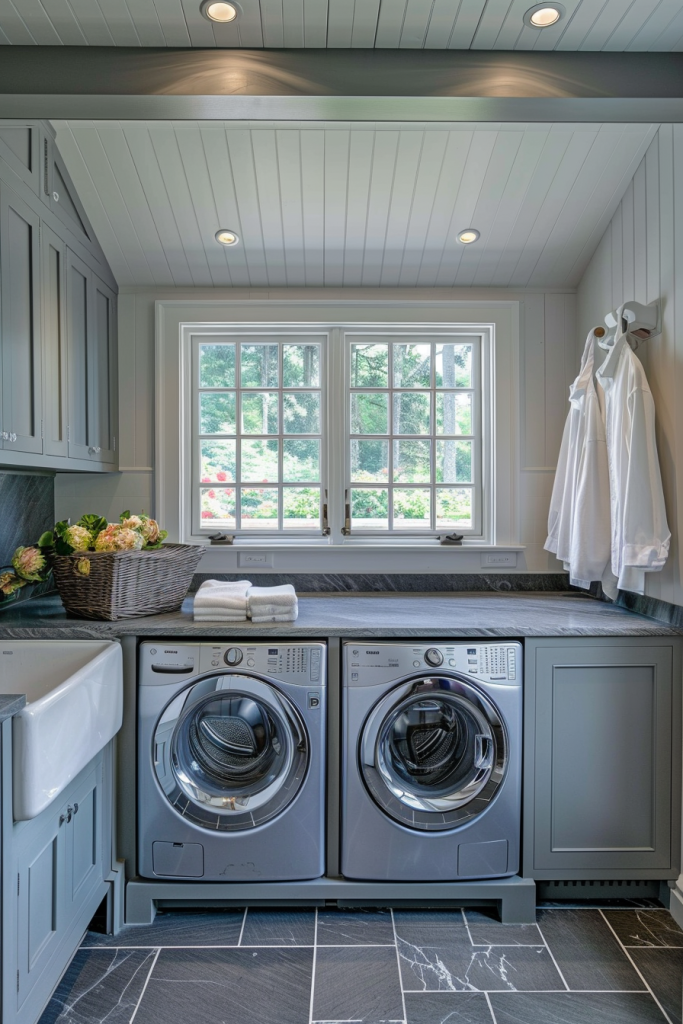
Maximizing Space
Whether your laundry room is large or small, maximizing space is crucial. Here are some tips to make the most of every inch:
- Vertical Space: Use tall cabinets and shelves to take advantage of vertical space. This is especially useful in narrow or compact rooms.
- Corner Units: Install corner shelves or cabinets to utilize often-overlooked corner spaces effectively.
- Multipurpose Furniture: Consider furniture that serves multiple functions, such as a bench with storage underneath or a folding table that doubles as a storage unit.
Accessibility and Safety
Ensure that your laundry room layout is accessible and safe for all users.
- Reaching Appliances: Ensure that controls and doors on appliances are at a comfortable height and easy to reach.
- Safe Walkways: Keep walkways clear of obstacles to prevent tripping hazards. This is especially important if the laundry room doubles as a mudroom or entryway.
- Proper Ventilation: Install proper ventilation to prevent moisture buildup, which can lead to mold and mildew. Consider a vented exhaust fan if your laundry room does not have windows.
Design Considerations
While functionality is paramount, don’t forget to incorporate design elements that make the room pleasant to spend time in.
- Color and Light: Choose light, bright colors to make the room feel more spacious and welcoming. Ensure there is adequate lighting, including task lighting in key areas.
- Personal Touches: Add personal touches like artwork, decorative baskets, or a comfortable rug to make the space feel inviting and reflective of your style.
Planning Tools
Use planning tools like graph paper, design software, or online room planners to sketch out different layout options. Visualizing your ideas can help you see how everything will fit together and make any necessary adjustments before you start the actual work.
Thoughtful placement of appliances, furniture, and storage solutions ensures that every aspect of your laundry routine is as efficient and pleasant as possible.

Choosing Your Color Scheme
Selecting the right color scheme for your laundry room is crucial for creating a space that is both visually appealing and conducive to its intended use. Colors can influence mood, enhance the perception of space, and tie together the overall design. Here’s a comprehensive guide to help you choose the perfect color scheme for your laundry room.
Understanding Color Psychology
Colors have the power to evoke emotions and set the tone of a room. Here’s how different colors can affect the atmosphere in your laundry room:
- White: Represents cleanliness and simplicity. It can make the space feel larger and more open, and provides a neutral backdrop for other design elements.
- Blue: A calming and refreshing color, perfect for creating a serene environment. Light blues can make a small room feel more spacious, while darker blues add depth and sophistication.
- Green: Associated with nature and tranquility. Soft greens can create a relaxing atmosphere, while vibrant greens can add a touch of energy.
- Yellow: A cheerful and energizing color. It can brighten up the space and make it feel more inviting.
- Gray: A versatile and modern color that pairs well with many other hues. Light grays can create a sleek, contemporary look, while darker grays add a sense of coziness.
- Beige and Neutrals: Timeless and adaptable, neutral tones provide a warm and inviting base. They allow for flexibility in incorporating other colors through decor and accessories.
Choosing the Right Palette
When selecting a color palette, consider the following factors:
- Room Size: Light colors can make a small laundry room feel larger and more open, while dark colors can create a cozy atmosphere in a larger space.
- Natural Light: Rooms with ample natural light can handle darker, bolder colors, while those with limited light may benefit from lighter, brighter shades.
- Existing Elements: Consider the colors of existing fixtures, flooring, and cabinetry. Choose a palette that complements these elements for a harmonious look.
- Style Preferences: Your chosen design style will influence your color scheme. For example, a modern style might favor neutral tones with bold accents, while a farmhouse style might incorporate soft, muted colors.
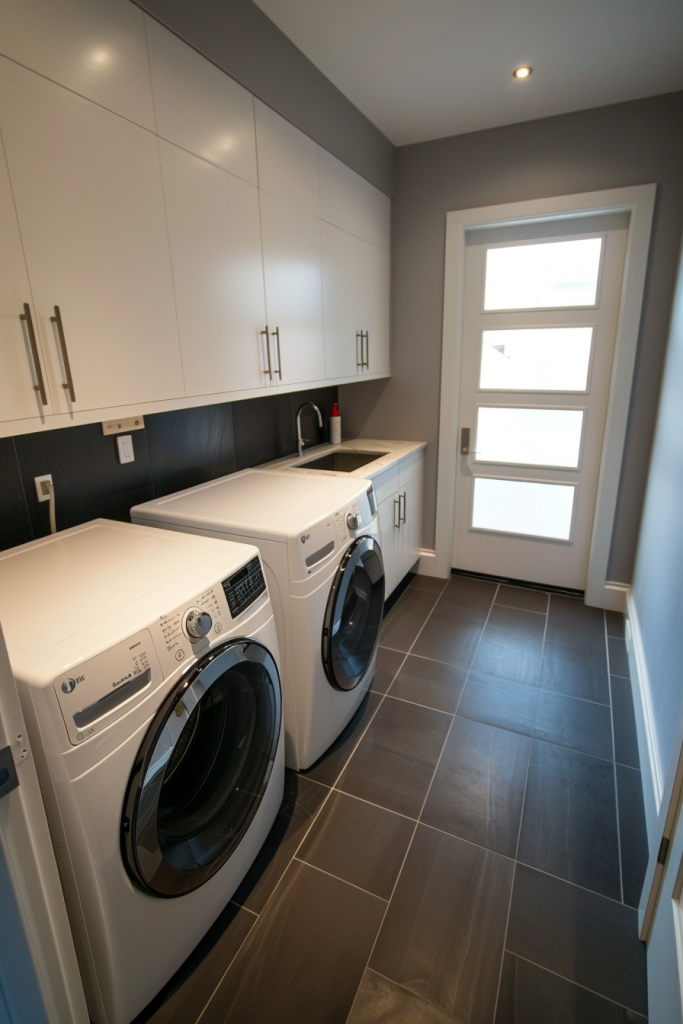
Creating Balance and Harmony
Achieving balance and harmony in your color scheme involves combining colors in a way that is visually pleasing and cohesive.
- Primary, Secondary, and Accent Colors: Choose a primary color for the walls or largest surfaces, a secondary color for cabinetry or large decor pieces, and an accent color for smaller details and accessories.
- Color Proportions: Follow the 60-30-10 rule: 60% primary color, 30% secondary color, and 10% accent color. This creates a balanced look without overwhelming the space.
- Monochromatic Scheme: Use varying shades of the same color for a cohesive and sophisticated look. This can make the room feel more unified and serene.
- Complementary Scheme: Pair colors that are opposite each other on the color wheel, such as blue and orange or yellow and purple. This creates a dynamic and vibrant contrast.
- Analogous Scheme: Use colors that are next to each other on the color wheel, like blue, green, and teal. This creates a harmonious and soothing effect.
Practical Tips for Choosing Colors
Here are some practical tips to help you finalize your color scheme:
- Test Samples: Paint small sections of your walls with your chosen colors and observe them at different times of the day to see how they look under various lighting conditions.
- Start with Neutrals: If you’re unsure, start with a neutral base and add pops of color through accessories, textiles, and small decor items.
- Consider the Ceiling: A lighter color on the ceiling can make the room feel taller, while a darker color can create a more intimate and cozy atmosphere.
- Use Patterns Wisely: Incorporate patterns through tiles, wallpaper, or textiles to add visual interest without overwhelming the space.
Popular Color Combinations
Here are some popular color combinations to inspire you:
- Crisp White and Soft Gray: Creates a clean, modern look. Add metallic accents for a touch of sophistication.
- Navy Blue and White: A classic and timeless combination. Add wooden elements for warmth and contrast.
- Pale Blue and White: Creates a fresh, airy feel. Perfect for a coastal or beach-inspired laundry room.
- Mint Green and Beige: Offers a calming and natural vibe. Complement with natural wood finishes and plants.
- Yellow and Gray: A cheerful and contemporary combination. Use yellow as an accent to brighten up a predominantly gray space.
- Blush Pink and Cream: Adds a soft, feminine touch. Perfect for a chic and elegant laundry room.
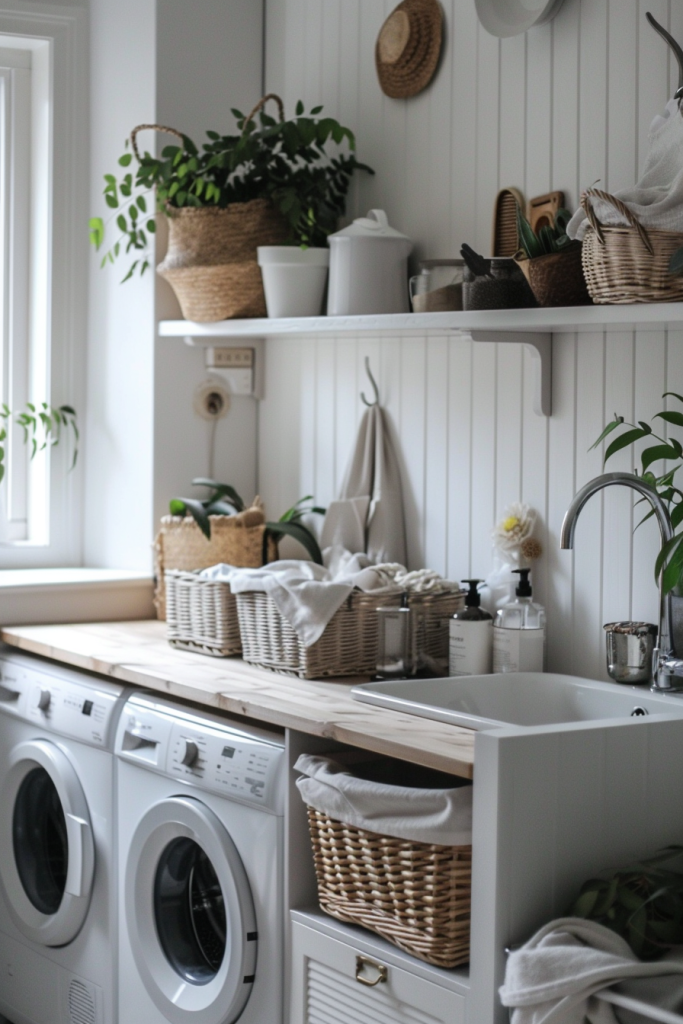
Incorporating Color Through Elements
Colors can be introduced through various elements in your laundry room:
- Decor and Accessories: Introduce accent colors through baskets, bins, artwork, and textiles.
- Walls and Ceilings: The primary canvas for your color scheme. Consider using paint, wallpaper, or tile.
- Cabinetry and Shelving: Choose colors that complement or contrast with the walls for added depth.
- Countertops and Backsplashes: Use materials that introduce color and texture, such as colorful tiles or patterned stone.
- Flooring: Consider tiles, vinyl, or rugs that add color and pattern to the space.
Selecting Materials and Textures
Choosing the right materials and textures for your laundry room is crucial for creating a space that is not only aesthetically pleasing but also durable and functional. The materials and textures you select will impact the room’s overall look, feel, and performance. Here’s a detailed guide to help you make informed decisions.
Flooring
The flooring in your laundry room needs to withstand heavy foot traffic, moisture, and the occasional spill. Here are some popular and practical flooring options:
- Ceramic or Porcelain Tile: Durable, water-resistant, and available in a wide range of colors and patterns. Tiles can mimic the look of wood or stone, providing a stylish yet practical flooring option.
- Vinyl Flooring: Water-resistant and easy to clean, vinyl is a budget-friendly option that comes in various styles, including sheets, tiles, and planks. It can mimic the appearance of more expensive materials.
- Laminate Flooring: Another cost-effective option that can imitate wood or stone. Ensure you choose a water-resistant laminate to handle the humidity and potential spills in a laundry room.
- Concrete: Ideal for a modern or industrial look. Concrete floors are highly durable and can be stained or painted to add color and pattern.
- Natural Stone: Adds a touch of luxury and elegance. Ensure the stone is sealed to protect it from moisture and stains.
Countertops
Countertops in the laundry room should be durable, easy to clean, and resistant to moisture. Consider the following materials:
- Quartz: Non-porous and highly resistant to stains and scratches. Quartz countertops are available in a variety of colors and patterns.
- Granite: Durable and heat-resistant, granite adds a touch of luxury. It needs to be sealed regularly to maintain its resistance to moisture and stains.
- Laminate: An affordable option that comes in many colors and patterns. While not as durable as stone, laminate countertops are easy to clean and maintain.
- Solid Surface: Made from acrylic or polyester, solid surface countertops are seamless and easy to clean. They can be repaired if scratched or damaged.

Cabinetry and Shelving
The materials for your cabinets and shelves should be durable and able to withstand the humidity of a laundry room. Here are some options:
- Solid Wood: Adds warmth and a natural touch. Ensure the wood is treated to resist moisture.
- Plywood: A more affordable alternative to solid wood, plywood is durable and resistant to warping.
- MDF (Medium-Density Fiberboard): An economical option that can be painted or laminated to match your design. It’s important to choose water-resistant MDF for the laundry room.
- Metal: Ideal for an industrial look, metal shelves and cabinets are durable and easy to clean. Stainless steel is a popular choice for its sleek appearance and resistance to moisture.
Walls and Backsplashes
The walls and backsplashes in your laundry room can add color and texture while protecting the surfaces from moisture and stains. Consider these materials:
- Paint: Use high-quality, washable paint that can withstand moisture and frequent cleaning. Semi-gloss or satin finishes are ideal for their durability.
- Tile: Ceramic or glass tiles are easy to clean and resistant to moisture. They come in a wide range of colors and patterns, allowing for creative backsplash designs.
- Wallpaper: Choose moisture-resistant wallpaper for a unique and stylish look. There are many options available that are designed specifically for high-humidity areas.
- Beadboard: Adds a charming, classic touch and is easy to clean. Beadboard can be painted to match or contrast with the walls.
Textiles
Textiles in the laundry room, such as rugs, curtains, and towels, can add warmth and comfort. Here are some options to consider:
- Rugs and Mats: Choose water-resistant and washable rugs or mats to protect the floor and add a touch of style.
- Curtains: Light, washable fabrics like cotton or linen are ideal for window treatments. Consider moisture-resistant options for durability.
- Towels and Linens: High-quality, absorbent towels and linens can add both functionality and a touch of luxury to your laundry room.
Finishing Touches
Incorporating various textures through finishing touches can enhance the room’s visual appeal and create a more inviting space:
- Hardware: Choose cabinet handles and knobs in materials like brushed nickel, brass, or stainless steel to complement your overall design.
- Lighting Fixtures: Select fixtures that match the room’s style. Materials like metal, glass, or fabric can add texture and interest.
- Decorative Elements: Use baskets, bins, and containers made from materials like wicker, metal, or fabric to add both texture and functionality.

Durability and Maintenance
When selecting materials, consider their durability and ease of maintenance:
- Water Resistance: Ensure materials are water-resistant to prevent damage from spills, humidity, and frequent cleaning.
- Stain Resistance: Choose materials that are easy to clean and resist staining from detergents, bleach, and other laundry room chemicals.
- Longevity: Invest in high-quality materials that will stand the test of time and maintain their appearance with minimal upkeep.
Lighting the Room
Proper lighting is essential in a laundry room to ensure that you can see clearly while performing tasks, create a pleasant atmosphere, and highlight the room’s design features. Effective lighting combines ambient, task, and accent lighting to cover all your needs. Here’s a detailed guide on how to light your laundry room effectively.
Ambient Lighting
Ambient lighting provides general illumination for the entire room, ensuring that it is well-lit and comfortable to work in.
- Ceiling Fixtures: Install ceiling-mounted fixtures such as flush-mount lights, semi-flush-mount lights, or chandeliers for a more decorative touch. These provide overall illumination for the space.
- Recessed Lighting: Recessed or can lights offer a sleek, modern look and can be spaced evenly across the ceiling to ensure uniform lighting. They are particularly useful in rooms with lower ceilings.
- Track Lighting: Track lighting systems allow you to direct light where it’s needed most. This flexibility can be particularly useful in larger laundry rooms or those with multiple work areas.
- LED Panels: LED ceiling panels provide bright, energy-efficient lighting and can be a good option for a modern, minimalist look.
Task Lighting
Task lighting is focused on specific areas where detailed work is done, ensuring that these spots are well-lit and reducing eye strain.
- Under-Cabinet Lights: Install LED strip lights or puck lights under cabinets to illuminate countertops and work surfaces. This makes it easier to see while sorting, folding, or treating stains.
- Overhead Lighting: Place a dedicated light fixture above the washer and dryer, ironing board, or utility sink to provide direct light for these tasks.
- Pendant Lights: Hang pendant lights over workstations or islands to offer focused light and add a stylish element to the room’s decor.
- Portable Task Lights: Consider adding portable or clip-on lights that can be moved and directed as needed for specific tasks or areas.
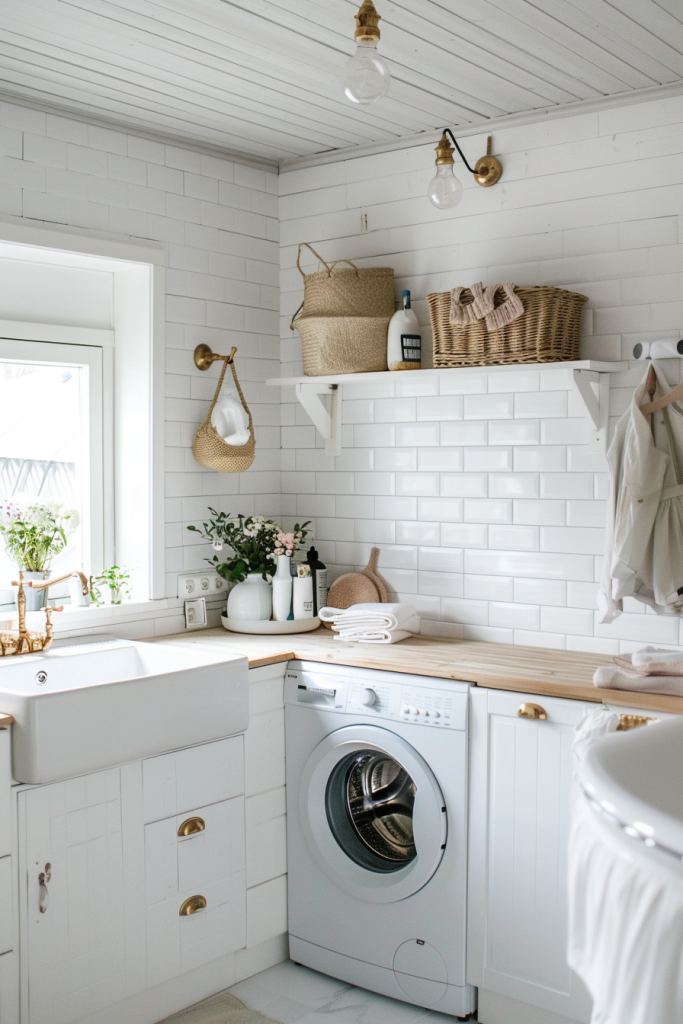
Accent Lighting
Accent lighting is used to highlight architectural features, decorative elements, or create a certain mood in the room.
- Wall Sconces: Install wall sconces to add ambient light and highlight wall decor or cabinetry. They can add a touch of elegance and warmth to the space.
- Shelf Lighting: Use LED strips or small spotlights to illuminate open shelves or cabinets with glass doors. This not only adds light but also showcases decorative items or neatly organized supplies.
- Floor Lighting: In larger laundry rooms, consider floor-level lighting along baseboards or under cabinets for a subtle, modern accent.
- Decorative Fixtures: Chandeliers, decorative pendant lights, or unique lamps can serve as focal points and add a touch of personality to the room.
Natural Light
Maximize natural light whenever possible to create a bright and inviting space.
- Windows: If your laundry room has windows, make the most of them by keeping window treatments minimal. Sheer curtains or blinds that can be easily opened allow for maximum light while providing privacy when needed.
- Skylights: In rooms without windows, consider installing a skylight or solar tube to bring in natural light from above. This can make a significant difference in the brightness and feel of the room.
- Mirrors: Strategically place mirrors to reflect natural light and make the room feel larger and more open.
Lighting Controls
Incorporating various lighting controls can enhance the functionality and efficiency of your laundry room’s lighting.
- Dimmers: Install dimmer switches to adjust the brightness of the lights according to your needs and preferences. This is particularly useful for creating different moods and saving energy.
- Motion Sensors: Use motion sensor lights for convenience and energy savings, especially in areas like closets or entryways where lights are often left on unintentionally.
- Smart Lighting: Consider smart lighting systems that can be controlled via smartphone or voice commands. These systems allow you to adjust lighting settings, colors, and schedules easily.
Energy Efficiency
Opt for energy-efficient lighting solutions to reduce your energy consumption and lower your utility bills.
- LED Bulbs: Use LED bulbs for all your lighting needs. They are highly energy-efficient, have a long lifespan, and produce less heat compared to incandescent or fluorescent bulbs.
- Energy Star Fixtures: Choose fixtures that are Energy Star rated, ensuring they meet strict energy efficiency guidelines.
- Natural Light Utilization: Maximize the use of natural light to reduce the need for artificial lighting during the day. This not only saves energy but also creates a more pleasant and natural atmosphere.
Design Integration
Ensure that your lighting choices complement the overall design and style of your laundry room.
- Layering: Layer different types of lighting to add depth and dimension to the room. Combining ambient, task, and accent lighting creates a balanced and functional lighting scheme.
- Consistency: Maintain a consistent style for your lighting fixtures to create a cohesive look. Whether you prefer modern, industrial, farmhouse, or traditional, choose fixtures that align with your design theme.
- Finish Matching: Match the finishes of your light fixtures with other hardware and elements in the room, such as cabinet handles, faucets, and door knobs.

Tech and Smart Features
Incorporating technology and smart features into your laundry room can enhance convenience, efficiency, and even energy savings. Modern advancements offer a range of options to make your laundry routine smoother and more enjoyable. Here’s a comprehensive guide to integrating tech and smart features into your laundry room.
Smart Appliances
Smart washers and dryers offer numerous benefits, from remote operation to energy management.
- Voice Control: Integrate with smart home systems like Amazon Alexa or Google Assistant to control your appliances using voice commands.
- Wi-Fi Connectivity: Smart washers and dryers can be connected to your home Wi-Fi network, allowing you to control and monitor them remotely using a smartphone app.
- Remote Monitoring: Receive notifications on your phone when a cycle is complete, enabling you to manage your laundry without needing to check the machines constantly.
- Energy Efficiency: Many smart appliances come with energy-saving modes and usage reports to help you reduce your electricity consumption and save on utility bills.
- Cycle Customization: Customize and save your preferred wash and dry cycles. Some models even recommend optimal settings based on the type of load.
Smart Lighting
Smart lighting can greatly enhance the functionality and ambiance of your laundry room.
- Automated Schedules: Program your lights to turn on and off at specific times, ensuring your laundry room is always well-lit when you need it.
- Motion Sensors: Install motion sensor lights that automatically turn on when you enter the room and off when you leave, improving convenience and energy efficiency.
- Color and Brightness Control: Adjust the color and brightness of your lights through a smartphone app or voice command to suit different tasks and moods.
- Energy Monitoring: Track energy usage of your lighting to identify ways to reduce consumption and save on electricity bills.
Smart Plugs and Outlets
Smart plugs and outlets can turn regular appliances into smart devices, offering additional control and automation.
- Remote Control: Use smart plugs to control non-smart appliances remotely, such as irons, steamers, or even coffee makers, through your smartphone.
- Energy Monitoring: Monitor the energy consumption of plugged-in devices to manage usage more effectively.
- Scheduling: Set schedules for your appliances to turn on and off automatically, enhancing convenience and energy efficiency.
Water Leak Detectors
Prevent water damage by installing smart water leak detectors in your laundry room.
- Real-Time Alerts: Receive instant notifications on your smartphone if a leak is detected, allowing you to take immediate action.
- Automatic Shutoff: Some advanced models can be integrated with smart valves to automatically shut off the water supply in case of a leak, preventing extensive damage.
- Integration: Connect leak detectors with your smart home system to trigger additional actions, such as turning on lights or sounding an alarm.
Smart Thermostats
A smart thermostat can help maintain a comfortable temperature in your laundry room and contribute to overall energy savings.
- Temperature Control: Adjust the temperature of your laundry room remotely through your smartphone or via voice commands.
- Energy Savings: Use smart scheduling and energy reports to optimize heating and cooling, reducing your utility bills.
- Integration: Integrate with other smart devices to create a seamless home automation system.
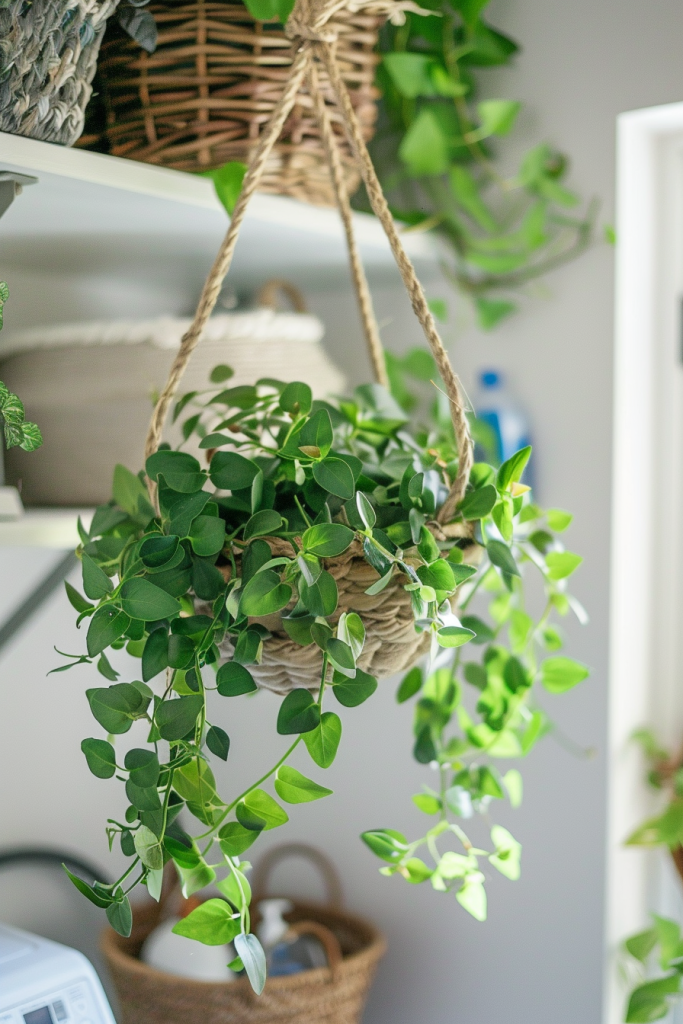
Ventilation and Air Quality
Ensure good air quality and ventilation in your laundry room with smart solutions.
- Smart Ventilation Fans: Install smart ventilation fans that can be controlled remotely and scheduled to run during and after laundry cycles to remove excess moisture and odors.
- Air Purifiers: Use smart air purifiers to maintain clean air, especially if your laundry room also serves as a multipurpose space.
- Humidity Sensors: Monitor humidity levels with smart sensors to prevent mold and mildew growth. These sensors can trigger your ventilation system to maintain optimal air quality.
Automated Blinds and Shades
Enhance the lighting and privacy in your laundry room with automated window treatments.
- Remote Operation: Control blinds and shades remotely through a smartphone app, allowing you to adjust natural light levels easily.
- Scheduling: Program your blinds to open and close at specific times to take advantage of natural light and improve energy efficiency.
- Integration: Integrate with your smart home system to automate window treatments based on room occupancy or time of day.
Laundry Room Entertainment
Make laundry time more enjoyable with integrated entertainment options.
- Smart Speakers: Install smart speakers to listen to music, podcasts, or audiobooks while you do laundry. These can also serve as a hub for controlling other smart devices in the room.
- Smart TVs or Displays: Mount a smart TV or display on the wall to watch your favorite shows or follow along with how-to videos for laundry tips and tricks.
- Voice Assistants: Use voice assistants like Amazon Alexa or Google Assistant to control your entertainment options hands-free while you work.
Smart Storage Solutions
Optimize your storage with smart organization and tracking systems.
- Inventory Management: Use smart shelves and bins with integrated inventory tracking to keep track of your laundry supplies. Receive alerts when you’re running low on detergents, fabric softeners, or other essentials.
- Automated Restocking: Connect your inventory system to online shopping services for automatic reordering of supplies when levels get low.
Integrating Smart Features
To make the most of your smart laundry room, integrate all your smart devices into a cohesive system.
- Smart Home Hubs: Use a smart home hub or platform like Amazon Echo, Google Nest, or Apple HomeKit to centralize control of all your devices. This allows for seamless automation and coordination between different systems.
- Custom Routines: Create custom routines that automate multiple actions. For example, a “Laundry Day” routine could adjust the thermostat, turn on lights, and start a playlist when you begin a laundry cycle.
- Voice Control: Utilize voice commands to control various devices and functions, making multitasking easier and more efficient.

Decor and Finishing Touches
The decor and finishing touches in your laundry room can transform it from a purely functional space into an inviting, stylish, and personalized area. Here are some detailed ideas and tips to help you add those final elements that make your laundry room truly special.
Artwork and Decorations
Adding artwork and decorative items can infuse personality and charm into your laundry room.
- Wall Art: Choose art pieces that reflect your style and the overall theme of your home. This could include framed prints, canvas paintings, or even DIY art. Look for artwork that adds color and interest without overwhelming the space.
- Signs and Quotes: Decorative signs with inspirational quotes, humorous sayings, or laundry-related messages can add a touch of whimsy and personalization.
- Photo Displays: Create a gallery wall with family photos or snapshots of memorable moments. This can make the space feel more personal and welcoming.
- Decorative Shelves: Install shelves to display decorative items such as small plants, vases, or collectibles. These can add depth and interest to the walls.
Plants
Incorporating plants into your laundry room decor can bring a sense of freshness and natural beauty.
- Low-Maintenance Plants: Choose plants that thrive in indoor environments and require minimal care, such as snake plants, pothos, or succulents. These plants can tolerate low light and occasional neglect.
- Hanging Plants: Use hanging planters to add greenery without taking up counter or shelf space. This can create a lush, vertical garden effect.
- Shelf Plants: Place small potted plants on shelves or countertops. These can add a pop of color and a touch of nature to the room.
- Herb Garden: If your laundry room has sufficient natural light, consider growing a small herb garden. This can add both visual appeal and functionality, providing fresh herbs for your kitchen.
Textiles and Soft Furnishings
Textiles can add warmth, color, and texture to your laundry room, making it feel more cozy and inviting.
- Rugs and Mats: Choose washable rugs or mats to place in front of the washer and dryer, sink, or entryway. These can protect your floors and add comfort underfoot. Opt for patterns or colors that complement your overall design.
- Curtains and Blinds: Dress your windows with stylish yet functional window treatments. Light-filtering curtains or blinds can provide privacy while allowing natural light to brighten the space.
- Cushions and Pillows: If your laundry room has a seating area, add cushions or pillows in coordinating fabrics. This can make the space more comfortable and visually appealing.

Storage Baskets and Containers
Stylish storage solutions can keep your laundry room organized while adding to its decor.
- Wicker Baskets: Use wicker baskets for a rustic, farmhouse look. They can hold laundry supplies, towels, or even dirty clothes. Choose baskets with lids for a neater appearance.
- Metal Bins: For an industrial touch, opt for metal bins or wire baskets. These can store cleaning supplies, clothespins, or other small items.
- Fabric Bins: Soft fabric bins or hampers can add a cozy feel and come in various colors and patterns to match your decor.
- Glass Jars: Store small items like detergent pods, dryer sheets, or clothespins in clear glass jars. This not only keeps them organized but also adds a decorative element.
Lighting Fixtures
Choose lighting fixtures that complement your decor and add a stylish touch to the room.
- Pendant Lights: Install pendant lights above work areas for both functional lighting and a design statement. Choose fixtures with interesting shapes or finishes to add visual interest.
- Chandeliers: If your ceiling height allows, consider adding a chandelier for a touch of elegance and sophistication.
- Wall Sconces: Wall sconces can provide additional lighting and add a decorative element to the walls. Choose sconces that match your overall style.
Personal Touches
Incorporate elements that reflect your personality and make the space uniquely yours.
- DIY Projects: Add custom, handmade items like painted signs, crafted storage solutions, or personalized laundry bags. These projects can add a personal and creative touch to the room.
- Themed Decor: Choose a theme that resonates with you, such as coastal, vintage, or modern, and incorporate themed elements throughout the room.
- Hobby Space: If space allows, integrate a small area dedicated to a hobby or activity you enjoy, such as crafting, gardening, or pet care.
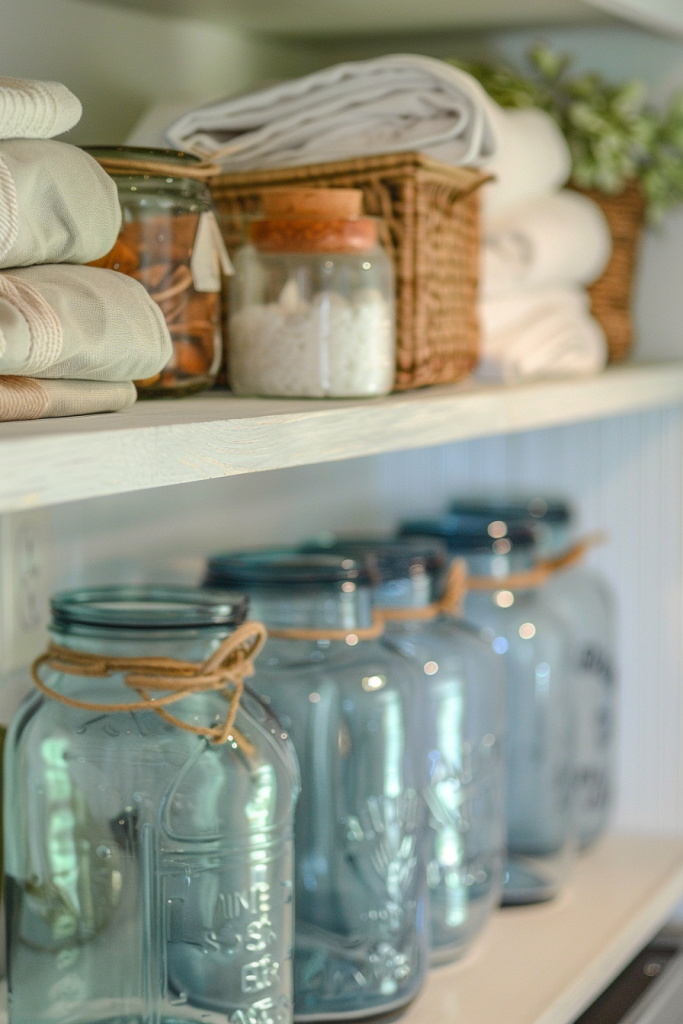
Functional Decor
Combine functionality with aesthetics to enhance the practicality of the room while keeping it visually appealing.
- Pegboards: Install a pegboard to organize tools, cleaning supplies, or small laundry items. Customize it with hooks, shelves, and baskets for a versatile storage solution.
- Hooks and Racks: Use decorative hooks or racks to hang items like ironing boards, brooms, or aprons. This keeps them easily accessible and adds to the decor.
- Drying Racks: Choose stylish drying racks that can be folded away when not in use. Wall-mounted or ceiling-hung options can save space and add a design element.
Seasonal and Rotating Decor
Change up the decor to reflect different seasons or holidays, keeping the space fresh and engaging.
- Rotating Art: Swap out artwork or decorative items periodically to keep the space feeling new and exciting. This can be as simple as changing the prints in your frames or updating the items on your shelves.
- Seasonal Accents: Add seasonal touches such as fresh flowers in spring, beach-themed decor in summer, autumnal colors in fall, and festive decorations in winter.
Budgeting and Planning
Successfully transforming your laundry room requires careful budgeting and planning. This ensures that the project stays within your financial means and is completed on time. Here’s a comprehensive guide to help you budget and plan your laundry room renovation effectively.
Setting Your Budget
Start by determining how much you are willing to spend on your laundry room renovation. Consider the following factors when setting your budget:
- Scope of the Project: Determine whether you are doing a full renovation or just making a few updates. A full renovation will require a larger budget.
- Priorities: Identify which aspects of the renovation are most important to you. Allocate more of your budget to these areas.
- Contingency Fund: Set aside 10-15% of your budget as a contingency fund for unexpected expenses or changes during the project.
Estimating Costs
Break down the estimated costs for each component of the renovation. Here are some common elements to consider:
- Design Fees: If you’re hiring a designer, factor in their fees. This can range from a flat fee to an hourly rate or a percentage of the project cost.
- Materials: Calculate the cost of materials such as flooring, cabinetry, countertops, paint, tiles, and hardware. Get quotes from multiple suppliers to find the best prices.
- Labor: Include the cost of hiring contractors, electricians, plumbers, and any other professionals needed for the project.
- Appliances: Budget for new appliances if needed, such as a washer, dryer, or utility sink. Consider energy-efficient models that may have higher upfront costs but save money in the long run.
- Permits: Check if you need permits for any structural changes or electrical/plumbing work. Factor in the cost of obtaining these permits.
Creating a Timeline
Develop a realistic timeline for your project to ensure that it progresses smoothly and is completed on time.
- Project Phases: Divide the renovation into phases, such as planning and design, demolition, installation, and finishing touches.
- Milestones: Set key milestones for each phase of the project. This helps you track progress and stay on schedule.
- Lead Times: Consider the lead times for ordering materials and appliances. Some items may take several weeks to arrive.
- Contractor Availability: Coordinate with contractors and professionals to ensure they are available when needed. Schedule their work to avoid delays.
Planning the Project
A well-thought-out plan is essential for a successful renovation. Here are steps to help you plan effectively:
- Research and Inspiration: Gather ideas and inspiration from magazines, websites, and social media. Create a vision board or digital mood board to visualize your design.
- Design and Layout: Work with a designer or use design software to create a detailed layout of your laundry room. Ensure that the layout is functional and meets your needs.
- Material Selection: Choose materials and finishes that fit your budget and style. Consider durability, maintenance, and how they will look together.
- Detailed Plans: Develop detailed plans and specifications for the project. This includes measurements, materials, and a list of all tasks to be completed.
- Quotes and Bids: Obtain quotes from multiple contractors and suppliers. Compare their prices, services, and timelines to select the best options.
Hiring Professionals
Hiring the right professionals can make a significant difference in the quality and success of your renovation.
- Designers: A professional designer can help you create a cohesive and functional design. Look for designers with experience in laundry room renovations.
- Contractors: Choose contractors with good reviews and a proven track record. Ensure they are licensed, insured, and experienced in the type of work you need.
- Specialists: Depending on the scope of your project, you may need to hire electricians, plumbers, or HVAC specialists. Choose qualified and experienced professionals.
Managing the Renovation
Effective project management is crucial to keeping the renovation on track and within budget.
- Regular Communication: Maintain regular communication with your contractors and professionals. Schedule regular check-ins to discuss progress and address any issues.
- Stay Organized: Keep all project documents, contracts, and receipts organized. Use a project management tool or app to track tasks, timelines, and expenses.
- Monitor Budget: Regularly review your budget and expenses. Make adjustments as needed to stay within your financial limits.
- Quality Control: Inspect the work at each stage of the project to ensure it meets your standards. Address any concerns with your contractors promptly.
Where to Splurge and Where to Save
Knowing where to allocate your budget can help you get the most value from your renovation.
- Splurge On:
- Quality Appliances: Invest in high-quality, energy-efficient appliances that will last longer and save on utility bills.
- Durable Materials: Choose durable materials for high-use areas, such as countertops and flooring, to ensure longevity.
- Professional Labor: Hiring experienced professionals can prevent costly mistakes and ensure high-quality workmanship.
- Save On:
- DIY Tasks: Consider doing some tasks yourself, such as painting or installing shelving, to save on labor costs.
- Decor and Accessories: Find affordable decor and accessories that still enhance the room’s aesthetics. Consider DIY projects for a personal touch.
- Shop Sales: Look for sales, discounts, and clearance items for materials and appliances. This can significantly reduce costs.
Dealing with Contractors
Working effectively with contractors is key to a smooth renovation process.
- Clear Contracts: Ensure you have a clear, written contract with each contractor. It should outline the scope of work, timeline, payment schedule, and any warranties or guarantees.
- Communication: Maintain open and clear communication. Discuss expectations, timelines, and any changes to the project promptly.
- Payments: Follow the agreed-upon payment schedule. Avoid paying the full amount upfront. Instead, make incremental payments as work is completed.
- Feedback: Provide feedback and address any concerns promptly. Regular check-ins can help identify and resolve issues early.
Final Inspections and Finishing Touches
Once the main renovation work is completed, focus on final inspections and finishing touches.
- Maintenance Plan: Create a maintenance plan for your new laundry room. Regular upkeep will help keep it in excellent condition and extend the life of your appliances and materials.
- Inspect Work: Conduct a thorough inspection of the completed work. Ensure that everything meets your expectations and the agreed-upon standards.
- Final Payments: Make the final payment to contractors only after the work has been completed to your satisfaction.
- Finishing Touches: Add the final decor elements, organize the space, and ensure everything is functional and aesthetically pleasing.

